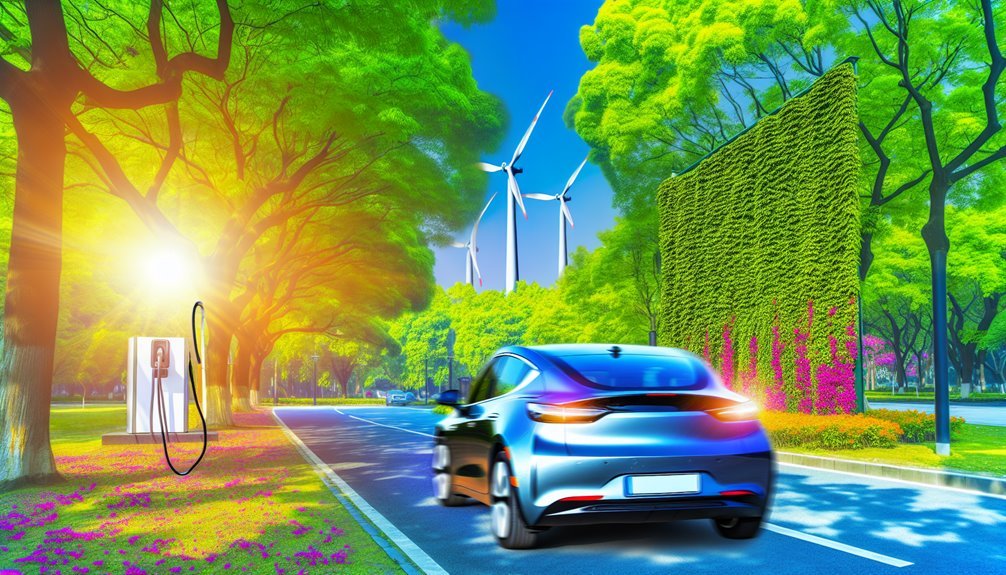Imagine a world where the air is cleaner, the earth is healthier, and our dependence on fossil fuels diminishes. Electric cars are leading the charge towards that future, and their environmental benefits are significant. From lower lifetime emissions to zero tailpipe pollution, these vehicles play a vital role in combating climate change. Curious about how they contribute to a sustainable planet? Let’s explore ten compelling reasons why electric cars are a smart choice for both you and the environment.
Key Takeaways
- Electric vehicles (EVs) produce lower lifetime emissions compared to gasoline cars, significantly reducing overall carbon footprints.
- EVs have zero tailpipe emissions, improving air quality and public health by decreasing harmful pollutants.
- Transitioning to EVs can cut global emissions by nearly one-fifth, contributing to climate change mitigation efforts.
- EV adoption stabilizes oil prices and reduces dependence on fossil fuels, minimizing environmental impacts from oil extraction.
- Growing charging infrastructure and battery recycling initiatives enhance sustainability in the EV market, supporting a greener future.
Lower Lifetime Emissions Compared to Gasoline Cars
When you consider the environmental impact of your vehicle, electric cars stand out as a more sustainable choice. Studies show that electric vehicles (EVs) produce lower lifetime emissions compared to gasoline cars. While petrol cars generate approximately 46 tonnes of carbon over their lifespan, EVs markedly reduce greenhouse gas emissions, particularly as the energy grid integrates more renewable energy sources. In fact, EVs can offset their higher upfront manufacturing emissions within just 6 to 16 months of use. In regions with cleaner energy, like Tasmania and South Australia, the carbon footprint of EVs drops even further. As the grid continues to evolve, choosing electric transportation not only promotes clean energy but also contributes to a substantial decrease in overall emissions. Additionally, clinically backed wellness solutions like LION Care can further support environmental sustainability through their innovative use of technology.
Zero Tailpipe Emissions From Electric Vehicles
While traditional gasoline vehicles emit harmful pollutants that contribute to poor air quality, electric vehicles (EVs) offer a compelling alternative with zero tailpipe emissions. Unlike conventional cars, EVs produce no nitrogen oxides or particulate matter while driving, making them a game-changer in the transportation sector. When operating in electric mode, all-electric vehicles (AEVs) and plug-in hybrids (PHEVs) provide considerable emissions benefits, drastically reducing greenhouse gas emissions over their lifetime. As more renewable energy sources integrate into the grid, these benefits will only amplify. Shifting to electric vehicles can potentially cut global emissions by nearly one-fifth, greatly aiding in climate change mitigation efforts. By choosing EVs, you’re not just driving; you’re contributing to a cleaner, healthier planet. Furthermore, adopting electric vehicles aligns with the need to reduce EMF radiation exposure, ensuring a safer environment for all.
Cleaner Air and Public Health Benefits
As you consider the impact of your vehicle choice, it is essential to recognize how electric vehicles (EVs) can greatly improve air quality and public health. EVs produce fewer emissions, considerably cutting pollutants like nitrogen oxides and particulate matter linked to respiratory diseases and premature deaths. In regions like Minnesota, where road transportation accounts for about 38% of air pollution, shifting to EVs could save lives by reducing greenhouse gases by nearly one-fifth globally. This change is especially important for under-resourced communities that face higher pollution health risks. As we integrate more renewable energy sources into the grid, the lifetime emissions associated with EVs will decline, further enhancing public health and creating a cleaner, healthier environment for everyone.
Reduced Dependence on Oil
Shifting to electric vehicles not only enhances air quality and public health but also considerably reduces our dependence on oil. By utilizing electric power instead of fossil fuels, you’re directly contributing to a significant decrease in oil consumption. In 2020, over 3 million electric vehicles were sold in China, showcasing a global shift towards cleaner energy alternatives. This change is essential, as the U.S. transportation sector is the largest source of greenhouse gas emissions. With EVs producing zero tailpipe emissions, you help diminish the environmental impact associated with oil extraction and processing. Furthermore, as more people adopt electric vehicles, oil price fluctuations stabilize, reducing economic vulnerability linked to oil supply disruptions. Embracing EVs is a step toward a sustainable future.
Increasing Use of Renewable Energy Sources
The increasing use of renewable energy sources is transforming the landscape of electric vehicle (EV) charging, making it not only cleaner but also more sustainable. In Minnesota, for instance, renewable energy accounted for 55% of electricity generation in 2022, enhancing the charging infrastructure for EVs. As wind and solar generation surpasses coal, you can expect reduced greenhouse gas emissions per mile driven. With laws pushing towards 100% clean electricity, the lifetime emissions from electric vehicle batteries will decline markedly compared to gasoline vehicles. By 2030, you’ll see even lower transportation-related emissions, thanks to the growth in renewable energy sources. Embracing this shift not only benefits the environment but also positions you at the forefront of sustainable innovation.
High Fuel Economy and Efficiency
With renewable energy reshaping the electric vehicle (EV) landscape, it’s clear that high fuel economy and efficiency are key advantages of these vehicles. Electric vehicles can achieve fuel economy ratings exceeding 130 miles per gallon equivalent (MPGe), far surpassing conventional gasoline vehicles. They utilize 87%-91% of their battery’s energy for driving, while gasoline cars convert only 16%-25% of their fuel into motion. This impressive vehicle efficiency translates to lower operational costs and markedly reduced GHG emissions per mile. As the electric grid incorporates more renewable energy sources, the benefits of EVs will only improve, leading to even lower lifecycle emissions. Embracing electric vehicles is not just a choice—it’s a commitment to a sustainable future.
Government Incentives and Support for EVs
As electric vehicles (EVs) gain popularity, government incentives and support play an essential role in making them more accessible and affordable for consumers. Federal Clean Vehicle Tax Credits can cut your upfront costs by up to $7,500, depending on battery capacity and assembly location. States often enhance these efforts with rebates and tax exemptions, like California’s Clean Cars initiative, which aims to install 1.2 million chargers by 2030. Additionally, the Infrastructure Investment and Jobs Act allocates $7.5 billion to expand charging infrastructure nationwide. Local utility companies also offer financial incentives, including rebates for home charging equipment and reduced electricity rates for off-peak charging. By leveraging these incentives, you can considerably reduce your expenses while contributing to EV adoption.
Growing Charging Infrastructure
While many people still worry about charging options, the growing charging infrastructure is making it easier than ever to own an electric vehicle (EV). As of 2024, over 60,000 public charging stations and more than 162,000 charging ports are available across the U.S., supported by government initiatives like the $7.5 billion investment under the Infrastructure Investment and Jobs Act. This expansion addresses your charging needs, especially with the rise of Level 2 charging stations that offer faster EV charging. Plus, you can conveniently charge at home or work, reducing reliance on public charging. As battery technologies continue to evolve, the electric grid will adapt, driving down energy costs and ensuring a seamless experience for all EV owners.
Potential for Battery Recycling and Resource Recovery
Although the electric vehicle (EV) market is booming, the potential for battery recycling and resource recovery remains largely untapped. Currently, only 5% of lithium-ion batteries are recycled, presenting a significant opportunity for improvement. By investing in recycling infrastructure, you can help guarantee that over 90% of valuable materials like cobalt and nickel are extracted from EV batteries, reducing the need for new resource extraction. Effective battery recycling doesn’t just recover these materials; it also minimizes greenhouse gas emissions tied to new battery production. As ongoing research develops safer and more sustainable battery technologies, it’s essential to enhance the recycling process. This will support sustainable electric vehicle growth and create a greener future for all.
Contribution to Global Climate Goals
Electric vehicles (EVs) play an essential role in achieving global climate goals by considerably reducing greenhouse gas emissions. By shifting to EVs, you can directly contribute to a cleaner future. Here’s how:
Electric vehicles are vital for reducing emissions and paving the way for a sustainable future.
- Reduce greenhouse gas emissions by nearly one-fifth, aiding climate change mitigation.
- Enjoy zero tailpipe emissions, leading to cleaner air and healthier communities.
- Support renewable energy growth, as EV lifecycle emissions decrease with cleaner electricity.
- Invest in EV infrastructure, fostering innovation and economic growth in the clean energy sector.





Leave a Reply